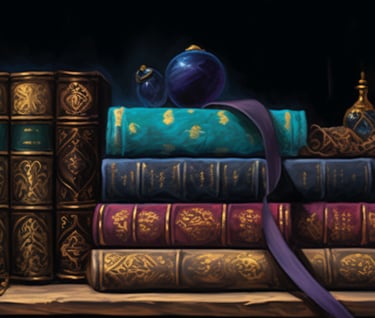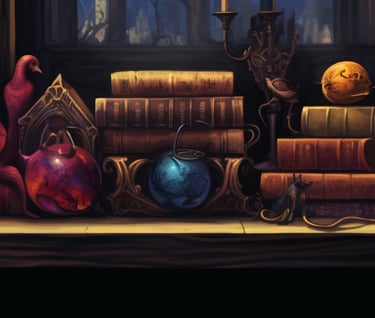Embracing Neurodiversity: A New Perspective on Character Development
Unlocking Authenticity in Fiction: Crafting Complex Characters Through Neurodiversity Insights
WRITINGDIVERSITYCREATIVITYWORLD BUILDING
Kat Sanders
9/1/202310 min read
Neurodiversity, a concept that recognizes and celebrates the wide range of differences in individual brain function and behavioral traits, has become increasingly relevant in modern society. It acknowledges conditions like autism, ADHD, dyslexia, and others not as disorders but as natural variations in the human brain. This perspective has not only shaped our understanding of human diversity but has also begun to influence various fields, including literature and media.
In the realm of storytelling, character development has evolved significantly over the years. Gone are the days when characters were mere stereotypes or one-dimensional figures. Today's readers and audiences crave complexity, authenticity, and depth in the characters they encounter. Embracing neurodiversity in character development opens a new dimension of creativity, allowing writers to craft characters that are not only more nuanced but also reflective of the diverse world we live in.
By integrating neurodiversity into the fabric of storytelling, writers can enrich their narratives, adding layers of realism and empathy that resonate with a broader audience. This approach goes beyond mere representation; it's about understanding the multifaceted nature of human experience and translating that understanding into characters that live and breathe on the page or screen. In this article, we'll explore how embracing neurodiversity can transform character development, offering insights and practical guidance for writers seeking to weave this vital aspect into their creative works.


Understanding Neurodiversity in Character Development
Understanding neurodiversity is a crucial step in character development, especially when aiming to create authentic and relatable characters. It requires a deep dive into various neurodiverse conditions and an awareness of how these conditions influence personality, motivation, and behavior. This section will explore the shift from stereotypes to genuine representation and the profound impact that neurodiversity can have on character development.
Explanation of Various Neurodiverse Conditions
Neurodiverse conditions such as autism, ADHD, and dyslexia are not abnormalities but natural variations in the human brain. Autism, for example, can affect social interaction and communication but also often comes with unique strengths like attention to detail. ADHD might lead to challenges in concentration but can also foster creativity and energy. Dyslexia, while affecting reading and writing skills, often enhances spatial reasoning and problem-solving abilities.
The Shift from Stereotypes to Authentic Representation
Historically, characters with neurodiverse conditions were often portrayed through stereotypes, reducing them to their challenges rather than embracing their complexity. Today, there's a growing movement towards authentic representation, recognizing that neurodiversity is not a hindrance but a facet of individuality. Writers are now exploring characters with neurodiverse conditions as whole beings, with desires, dreams, strengths, and weaknesses, just like any other character.
The Impact of Neurodiversity on Personality, Motivation, and Behavior
Neurodiversity significantly influences a character's personality, motivation, and behavior. For example, a character with autism might have a unique way of seeing the world, leading to unconventional problem-solving. A character with ADHD might be driven by a need for stimulation and excitement, influencing their choices and actions. Understanding these nuances allows writers to create characters that are not defined by their neurodiversity but enriched by it.
Embracing neurodiversity in character development is not just about inclusion; it's about enriching storytelling by reflecting the true diversity of human experience. By moving away from stereotypes and delving into the authentic representation of neurodiverse conditions, writers can create characters that resonate with readers on a deeper level. The impact of neurodiversity on personality, motivation, and behavior offers a rich tapestry of possibilities for character development, opening new avenues for creativity and connection. It's a journey that demands empathy, understanding, and a willingness to see characters not for their conditions but for their humanity.


The Art of Crafting Neurodiverse Characters
Crafting neurodiverse characters is more than a trend; it's an essential aspect of modern storytelling that adds depth and realism to narratives. It's about reflecting the diverse world we live in and connecting with a broader audience. This section delves into the art of creating well-rounded neurodiverse characters, focusing on avoiding clichés, embracing authenticity, and drawing from real-life examples.
Tips for Creating Well-Rounded Neurodiverse Characters
Creating well-rounded neurodiverse characters starts with understanding the specific condition you're portraying, whether it's autism, ADHD, dyslexia, or others. Research and empathy are key to this process. Treat neurodiverse characters as unique individuals, not defined solely by their neurodiversity. Consider their history, experiences, and how their neurodiversity has shaped them. This approach ensures that characters are multi-dimensional and relatable.
Avoiding Clichés and Stereotypes
Stereotypes and clichés can undermine the authenticity of neurodiverse characters. It's essential to steer clear of one-dimensional portrayals that reduce characters to their neurodiversity. Challenge common clichés, like the "savant" or the "tragic figure," and move beyond these limiting tropes. By creating characters with depth, interests, flaws, and strengths that go beyond their neurodiversity, writers can build more engaging and realistic characters.
The Importance of Research, Empathy, and Authenticity
Research, empathy, and authenticity are vital in crafting neurodiverse characters. Engaging with neurodiverse individuals, reading relevant literature, and consulting experts can ensure an authentic portrayal. Empathizing with the character, understanding their feelings, thoughts, and experiences, adds depth to the portrayal. Reflecting real-world diversity by creating characters that mirror our diverse society adds richness to the narrative.
Case Studies or Examples of Well-Written Neurodiverse Characters
Examining well-written neurodiverse characters can provide valuable insights. For example, the portrayal of Temple Grandin in "Temple Grandin" offers an authentic look at an autistic woman who becomes a top scientist in the humane livestock handling industry. Billy in "The Family Fang" is a character with dyslexia whose condition is part of his character but doesn't define him. These examples show how neurodiversity can be integrated into character development without falling into stereotypes.
The art of crafting neurodiverse characters is a delicate and rewarding process. It requires a commitment to authenticity, a willingness to research, and an empathetic approach. By avoiding clichés and stereotypes and focusing on well-rounded, individual characters, writers can create narratives that resonate with a broader audience. The inclusion of neurodiverse characters is not just a reflection of our diverse society; it's a step towards more inclusive storytelling. Let's continue to embrace this aspect of character development, recognizing the richness and complexity it brings to our creative works.


Intersectionality and Complexity
Neurodiversity doesn't exist in a vacuum; it's part of a complex web of identity that includes factors like race, gender, and sexuality. Understanding how these aspects interact is vital for creating authentic characters. For example, a neurodiverse individual's experience can be significantly shaped by their cultural background or gender identity. Recognizing these intersections adds layers to characters, making them more realistic and relatable.
The Challenge and Reward of Portraying Complex Characters
Creating characters that reflect the complexity of real people is both challenging and rewarding. It requires a deep understanding of human nature and a willingness to explore nuances. The challenge lies in balancing different aspects of identity without falling into stereotypes or oversimplification. However, the reward is immense. Complex characters are more engaging, more believable, and they allow for richer storytelling. They resonate with readers because they reflect the multifaceted nature of real people.
Strategies for Weaving Intersectionality into Character Development
Weaving intersectionality into character development is an art that requires careful consideration and strategy. Start by understanding the character's various identities and how they interact. Research and consult with people who share those identities to gain insight. Consider how neurodiversity might affect other aspects of the character's life, such as their relationships, career, or daily routines. Use these insights to build a character profile that reflects the complexity of their experience. Remember, intersectionality is not about adding traits to a character; it's about understanding how different aspects of their identity interact and shape their life.
Embracing intersectionality and complexity in character development is a vital step towards more authentic storytelling. It acknowledges that people are not defined by a single aspect of their identity but are shaped by a complex interplay of factors. By recognizing this complexity and weaving it into character development, writers can create characters that truly reflect the human experience. It's a challenging but rewarding process that enriches storytelling and connects with readers on a deeper level. Let's continue to explore this aspect of character development, recognizing the depth and richness it brings to our creative works.


Sensitivity and Responsibility
In the quest to create authentic neurodiverse characters, sensitivity readers and consultations with neurodiverse individuals can be invaluable. Sensitivity readers, often individuals who share or understand the traits being portrayed, can provide insights and feedback to ensure that the portrayal is respectful and accurate. Consulting with neurodiverse individuals offers a firsthand perspective that can deepen understanding and empathy. These collaborations foster a more nuanced and authentic depiction, bridging the gap between the writer's imagination and the lived experiences of neurodiverse individuals.
Ethical Considerations in Portraying Neurodiversity
Portraying neurodiversity in fiction carries ethical responsibilities. Writers must strive to avoid stereotypes, misrepresentations, or harmful tropes that can perpetuate misunderstandings or stigma. This requires a commitment to research, empathy, and a willingness to listen and learn from neurodiverse communities. Ethical portrayal goes beyond mere accuracy; it's about honoring the dignity and complexity of neurodiverse individuals, recognizing their humanity, and contributing to a more inclusive and empathetic literary landscape.
Balancing Creativity with Responsibility
Creativity is at the heart of storytelling, but it must be balanced with responsibility, especially when portraying neurodiversity. Writers have the freedom to explore and imagine, but this must be tempered with an awareness of the impact their portrayals can have. This balance requires a thoughtful approach that respects the experiences and identities being depicted. It's about recognizing that creative license has limits, especially when it comes to representing marginalized or misunderstood communities. Balancing creativity with responsibility ensures that storytelling is not just entertaining but also enlightening, respectful, and inclusive.
The journey to create neurodiverse characters is filled with opportunities for growth, understanding, and connection. By embracing sensitivity and responsibility, writers can contribute to a literary world that reflects the richness and diversity of human experience. Engaging with sensitivity readers, considering ethical implications, and balancing creativity with responsibility are not constraints but pathways to deeper, more authentic storytelling. Let's continue to navigate these pathways with care and commitment, recognizing that our words have the power to shape perceptions, foster empathy, and celebrate the beautiful complexity of neurodiversity.


Plot and Relationship Dynamics
Neurodiversity brings a unique dimension to plot and character relationships, offering fresh perspectives and dynamics. Characters with neurodiverse traits may perceive and interact with the world differently, leading to distinctive dialogues, reactions, and connections. These differences can create engaging and unexpected twists in the plot, enriching the story with layers of complexity and authenticity. By embracing neurodiversity, writers can explore new avenues of character development and relationship building, adding depth and resonance to their storytelling.
Strategies for Integrating Neurodiverse Themes into Main Storylines and Subplots
Integrating neurodiverse themes into main storylines and subplots requires thoughtful planning and execution. Writers must consider how neurodiversity fits into the overall narrative, ensuring that it serves a meaningful purpose and contributes to character growth or plot progression. This might involve weaving neurodiverse experiences into the central conflict, exploring neurodiversity through character backstories, or using it to enhance thematic elements. The key is to make neurodiversity an integral part of the story, not a superficial addition, thereby enriching the narrative with authenticity and depth.
The Potential for Unique Conflicts and Resolutions
Neurodiversity offers a fertile ground for unique conflicts and resolutions within a story. Characters' neurodiverse traits may lead to misunderstandings, challenges, or tensions that drive the plot forward. Conversely, these traits can also be sources of strength, creativity, and resilience, leading to innovative solutions and resolutions. By exploring the multifaceted nature of neurodiversity, writers can craft conflicts and resolutions that are not only engaging but also reflective of the diverse ways in which individuals navigate the world. This adds a layer of realism and intrigue to the story, making it more relatable and compelling.
Neurodiversity is not just a character trait; it's a dynamic force that can shape the very fabric of a story. From influencing character relationships to driving plot twists, from integrating into main storylines to creating unique conflicts and resolutions, neurodiversity offers a wealth of storytelling possibilities. By approaching neurodiversity with curiosity, empathy, and creativity, writers can craft narratives that are not only entertaining but also enlightening and inclusive. Let's continue to explore the narrative potential of neurodiversity, recognizing its power to enrich our stories and connect with a broader audience.


Embracing neurodiversity in storytelling is more than a creative choice; it's a pathway to richer, more authentic, and inclusive narratives. By understanding the nuances of neurodiverse conditions, avoiding stereotypes, and crafting well-rounded characters, writers can breathe life into stories that resonate with a broader audience. The intersectionality and complexity of neurodiverse characters, coupled with the ethical considerations and unique plot dynamics, offer fertile ground for exploration and innovation in storytelling.
Writers are encouraged to delve into the world of neurodiversity, recognizing its potential to enhance character development and enrich storytelling. By engaging with neurodiverse stories, consulting with sensitivity readers, and embracing the responsibility that comes with portrayal, writers can contribute to a more inclusive and empathetic literary landscape.
The journey into neurodiversity is not just about adding a layer to a character; it's about understanding, empathy, and celebration of human diversity. It's an invitation to explore new horizons in storytelling, to connect with readers on a deeper level, and to contribute to a world where everyone's story matters.
We invite you to continue exploring this fascinating subject and more on MarleeKat Creations. Your insights, experiences, and comments are valuable to us, and we encourage you to share your thoughts by leaving a comment below. Let's continue to craft stories that not only entertain but also enlighten, inspire, and connect. Together, we can shape a literary world that truly reflects the beautiful tapestry of human experience. Join the conversation and let your voice be heard!



